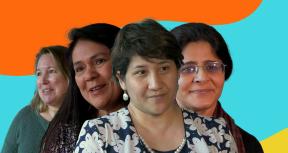Understanding geographic footprint of the Bank’s interventions is a necessary input into the analysis of spatial impact of development policy. Data needed for such monitoring was not available––until very recently.
TWEET THIS:
The World Bank Group established overarching twin goals in its 2013 Strategy: reducing global poverty to 3 percent by 2030, and boosting growth in the real incomes of the bottom 40 percent in each country. These twin goals are part of an international development agenda related to the United Nations Sustainable Development Goals 1 (poverty) and 10 (inequality) supported by the global community.
In a new IEG report - Growth for the Bottom 40 Percent - we evaluated how the World Bank Group has operationalized the new goal of shared prosperity. The report concludes that the World Bank Group has been making significant efforts towards shared prosperity but more needs to be done to translate those efforts into tangible development results.
It also finds that the Bank has been exercising its convening power at the global and country levels as noted by Caroline Heider and Auguste Tano Kouame in their blog Addressing Inequality: Can We Succeed?
Minding the geography
One area where improvement is necessary is monitoring of the geographic footprint of the World Bank Group projects to ascertain whether and to what extent they are located in the areas where the bottom 40 percent live. Of course, even under ideal circumstances, perfect correlation between the Bank projects and bottom 40 percent is not possible because of many intervening factors, including the distribution of the overall population and the poor, the role of the capital city etc. But understanding geographic footprint of the Bank’s interventions is a necessary input into the analysis of spatial impact of development policy. Data needed for such monitoring was not available––until very recently.
Thanks to the availability of household surveys and geospatial data in many countries, an innovative study carried out under this evaluation entitled Putting your Money where your Mouth is: Geographic Targeting of World Bank Projects to the Bottom 40 Percent provides a first analysis that sheds light on the question: just how does the territorial distribution of Bank projects correlate with the bottom 40 percent and what factors drive the observed correlations?
Mining the Geospatial Data
Data on the bottom 40 are based on household surveys in 58 countries on which geospatial data are available. The study has relied on harmonized surveys produced by the World Bank’s Poverty & Equity Global Practice. These surveys contain a welfare indicator (income or consumption), a geographic identifier, and a sample weight for each household. This makes it possible to calculate the number of individuals belonging to the bottom 40 in each first-level administrative division. Also, subnational information on the locations of World Bank projects is developed from the AidData database, which lists 1,517 World Bank investment projects approved in 58 countries between 2005 and 2014.
What Did we Find?
At first blush, the data provides a broadly favorable picture:
Table: Correlations between the Share of World Bank Projects and the Bottom 40 at Subnational Levels
|
Correlation coefficients
|
Countries
|
|---|
|
0.5 to 1.0
|
Armenia, Bangladesh, Bolivia, Bosnia and Herzegovina, Brazil, Cabo Verde, Chile, El Salvador, Ethiopia, India, Indonesia, Kyrgyz Republic, Lesotho, Madagascar, Mauritania, Nepal, Tajikistan, Timor-Leste, Uruguay, Republic of Yemen
|
|
0 to 0.5
|
Afghanistan, Angola, Bhutan, Burkina Faso, Cameroon, Chad, Ecuador, Guatemala, Haiti, Iraq, Kenya, Lao People’s Democratic Republic, Mali, Niger, Peru, Philippines, Republic of Congo, Russian Federation, Sri Lanka, Uganda, Ukraine, Vietnam
|
|
−0.5 to 0
|
Belarus, Burundi, Democratic Republic of Congo, Georgia, Ghana, Guinea-Bissau, Mexico, Mozambique, Nigeria, Senegal, South Africa, Tanzania
|
|
−1.0 to −0.5
|
Guinea, Rwanda, Sierra Leone, Zambia
|
Source: Hannes Ohler, Mario Negre, Lodewijk Smets, Renzo Massari and Zeljko Bogetic (2017).
In 72 percent of the cases, the presence of World Bank–supported projects is positively correlated with the presence of bottom 40 populations. This is assessed by correlating the distribution of project funds at one administrative level below the national level with the distribution of the national bottom 40 population across the same subnational administrative levels. As many as 42 countries present a positive correlation. In 20 of these countries (34 percent of the total), the correlation is at least 0.5, while the average is 0.26. However, the table also shows that World Bank projects in 16 countries are negatively correlated with the bottom 40. Partly, this is because project resources tend to flow to populous regions with capital cities, whereas most of the bottom 40 live elsewhere. Closer inspection suggests that this is the case mostly in African countries in the sample. The map below illustrates the case of a country with positive but imperfect overall correlation (0.34) that still shows a disproportion in the shares of the World Bank funding relative to the shares of the bottom 40 in these areas, especially in the north of the country.
Map: Shares of the Bottom 40 Percent and the Bank Projects in Lao PDR

Source: Hannes Ohler, Mario Negre, Lodewijk Smets, Renzo Massari and Zeljko Bogetic (2017).
So, the upshot is that the World Bank should be mindful of where it locates its projects and whether they benefit the areas where the bottom 40 live. To this end, the IEG has recommended that the Bank Group increase geospatial monitoring of its projects and their congruence with bottom 40, particularly when it is possible to identify the location of direct beneficiaries. Looking ahead, one way to extend this analysis and contribute to the effectiveness debate is to examine whether the projects located in the areas with high density of B40 achieve their development objectives or, if they do so with a greater probability than projects that are not congruent with the location of B40.








Comments
In my view, the next step…
In my view, the next step with this important research would be to determine in some case studies whether the Bottom 40% in the areas projects were run in, did actually benefit from the intervention or whether social, capital, or other barriers intervened to prevent them taking up benefits.
Add new comment